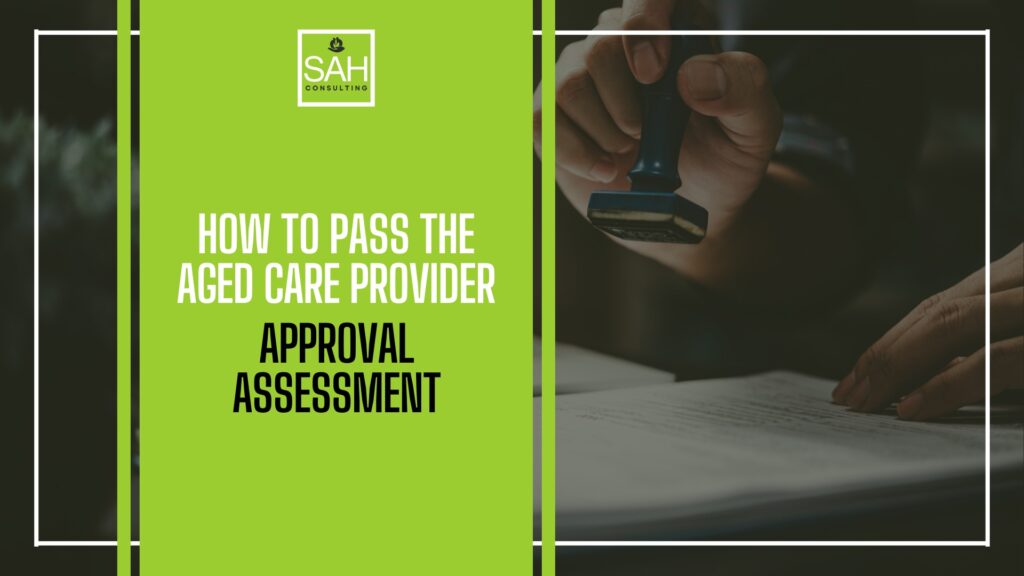Becoming an approved aged care provider in Australia is a crucial step for organisations looking to offer government-subsidised care under the Aged Care Act 1997. However, passing the provider approval assessment isn’t just about submitting an application—it requires demonstrating sound governance, financial stability, and a clear commitment to high-quality care.
Many providers fail due to incomplete documentation, lack of financial viability, or poor understanding of legal obligations. This guide will walk you through the provider approval assessment questions, ensuring you’re fully prepared to navigate the process and secure approval successfully.
Pre-Application: Must-Do Checks
You need to meet all the requirements and eligibility conditions before submitting an application to become an aged care provider. Following these basic steps will boost your chances of obtaining approval and prevent delays.
Confirm Eligibility
- Your organisation must be incorporated—sole traders are not eligible.
- Key personnel, including directors and executives, must pass police and insolvency checks to ensure they meet the suitability requirements.
- Your organisation must comply with provider governance requirements under the Aged Care Act 1997, including board composition, reporting obligations, and risk management procedures.
Choose the Right Care Type
Aged care providers must select the appropriate care type based on the services they intend to offer:
- Home Care: Supports older Australians living at home. Government subsidies are often paid in arrears, requiring strong financial backing.
- Residential Care: Provides 24/7 care in aged care facilities, requiring compliance with extensive quality and safety regulations.
- Flexible Care: Includes programs like short-term restorative care and transition care, each with unique regulatory requirements.
Demonstrate Financial Viability
- Submit financial statements that demonstrate stability and cash flow sufficiency.
- Provide evidence of funding sources and contingency plans.
- Show a history of responsible financial management.
By completing these pre-application checks, you can improve your chances of a smooth approval process and avoid common pitfalls that lead to application rejections.
The Application Process: Step-by-Step
Step 1: Pick the Correct Form
Select the proper application form from New Applicant, Existing Provider, or Government schemes. Your application must use the appropriate form to proceed without delay in the provider assessment phase.
Step 2: Gather Mandatory Documents
Prepare all required documents, such as statutory declarations, National Police Certificates (NPCs) less than 90 days old, and service agreements for subcontractors. Providing accurate and complete documentation reduces the chances of receiving a Request for Information, which could prolong the process.
Step 3: Submit Fees and Await Assessment
Once you submit your application and any required fees, it undergoes a four-stage assessment, including validity checks, initial assessment, and formal review. This process ensures compliance with regulatory requirements and helps determine how to become a service provider.
Step 4: Post-Approval Setup
If your application is approved, you’ll need to complete essential setup steps, including registering with My Aged Care and Services Australia. This final stage ensures that your organisation is fully integrated into the aged care system and ready to provide services.
After Approval: Staying Compliant & Transitioning to Support at Home
After approval, staying compliant is crucial to maintaining your provider status. Keep up with legislative updates, including the new Aged Care Act and the Support at Home program, which will replace Home Care Packages from 1 July 2025. Ensure proper incident reporting through the Serious Incident Response Scheme (SIRS) and prepare for regular audits by maintaining accurate records for ACQSC reviews. Staying proactive in compliance not only meets regulatory expectations but also helps you address provider approval assessment questions effectively.
Key changes under SAH
The Support at Home (SAH) program introduces major changes to aged care services, replacing the Home Care Packages (HCP) and Short-Term Restorative Care (STRC) programs with a more simplified, unified system. A key update is the Single Assessment System, launching in July 2025, which streamlines how older Australians are assessed for care.
Additionally, new funding arrangements will change how providers receive and manage payments. The Commonwealth Home Support Programme (CHSP) will transition into SAH by July 2027, meaning providers must start planning now to adjust their business models for the shift.
Need Help Transitioning?
Navigating the complexities of Support at Home (SAH) registration can feel overwhelming, with evolving regulations, detailed documentation, and strict compliance requirements. At SAH Consulting, we make the process easier by providing expert guidance every step of the way.
Our team helps you understand the latest SAH regulations, ensuring your application meets all necessary criteria. We assist with preparing robust applications, including gathering mandatory documentation and crafting policy and procedure manuals tailored for compliance and operational efficiency. If any issues arise, we’re here to address concerns, answer questions, and minimise delays—helping you avoid common pitfalls that could slow down approval.
How to Demonstrate Compliance
To demonstrate compliance, ensure your key personnel thoroughly understand aged care laws, including the Aged Care Act and Quality Standards. Develop customised policies—not generic templates—for care delivery, complaint handling, and incident management. Maintain strong financial systems to track subsidies and report accurately to the Department of Health.
If subcontracting, ensure all contracts align with Aged Care Quality Standards. Use clear examples to strengthen your application, such as showcasing how your HR policies enforce the Code of Conduct in daily operations.
Conclusion
Successfully registering as a Support at Home provider requires careful planning, compliance with evolving regulations, and a strong understanding of the provider approval assessment questions. From selecting the correct application form to maintaining compliance post-approval, each step plays a crucial role in ensuring a smooth transition.At SAH Consulting, we simplify the process, helping aged care providers navigate registration, adapt to new funding models, and stay compliant. Don’t let the complexities slow you down—contact us today to get SAH-ready and secure your place in the future of aged care.
